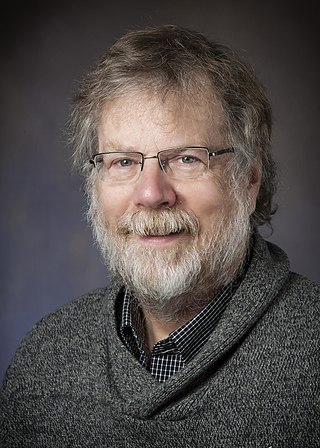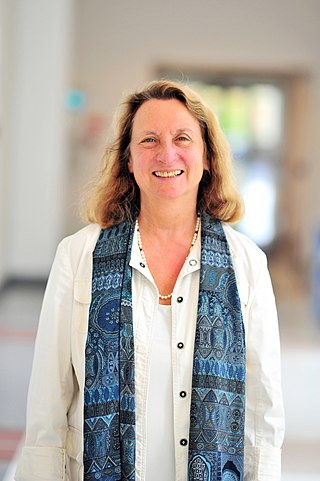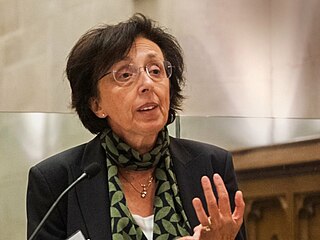Related Research Articles
Farid F. Abraham is an American scientist.
The Aneesur Rahman Prize for Computational Physics is a prize that has been awarded annually by the American Physical Society since 1993. The recipient is chosen for "outstanding achievement in computational physics research". The prize is named after Aneesur Rahman, pioneer of the molecular dynamics simulation method. The prize was valued at $5,000 from 2007 to 2014, and is currently valued at $10,000.
Steven R. White is a professor of physics at the University of California, Irvine. He is a condensed matter physicist who specializes in the simulation of quantum systems. He graduated from the University of California, San Diego; he then received his Ph.D. at Cornell University, where he was a shared student with Kenneth Wilson and John Wilkins.

Daan Frenkel is a Dutch computational physicist in the Department of Chemistry at the University of Cambridge.

Michael Lawrence KleinNAS is Laura H. Carnell Professor of Science and director of the Institute for Computational Molecular Science in the college of science and technology at Temple University in Philadelphia, US. He was previously the Hepburn Professor of Physical Science in the Center for Molecular Modeling at the University of Pennsylvania. Currently, he serves as the dean of the college of science and technology and has since 2013.
Steven Gwon Sheng Louie is a computational condensed-matter physicist. He is a professor of physics at the University of California, Berkeley and senior faculty scientist in the Materials Sciences Division at Lawrence Berkeley National Laboratory, where his research focuses on nanoscience. He is also scientific director of the Theory of Nanostructured Materials Facility at the Molecular Foundry.
Donald Henry Weingarten is a computational physicist.
John Myrick Dawson was an American computational physicist and the father of plasma-based acceleration techniques. Dawson earned his degrees in physics from the University of Maryland, College Park: a B.S. in 1952 and Ph.D. in 1957. His thesis "Distortion of Atoms and Molecules in Dense Media" was prepared under the guidance of Zaka Slawsky.
David Vanderbilt is a professor of physics at Rutgers University researching condensed-matter physics since 1991, and named Board of Governors Professor of Physics in 2009. He received his B.A. from Swarthmore College in 1976 and his Ph.D. from MIT in 1981 studying under John D. Joannopoulos. He received the Aneesur Rahman Prize for Computational Physics in 2006. The Aneesur Rahman prize is the highest honor given by the American Physical Society for work in computational physics. In 2013 he was elected to the National Academy of Science.
Uzi Landman is an Israeli/American computational physicist, the Fuller E. Callaway Professor of Computational Materials Science at the Georgia Institute of Technology.

David Matthew Ceperley is a theoretical physicist in the physics department at the University of Illinois Urbana-Champaign or UIUC. He is a world expert in the area of Quantum Monte Carlo computations, a method of calculation that is generally recognised to provide accurate quantitative results for many-body problems described by quantum mechanics.
David P. Landau is Distinguished Research Professor of Physics and founding Director of the Center for Simulational Physics at the University of Georgia. In 1967, he received his PhD at Yale University under the direction of Werner P. Wolf. Two years later, he moved to the University of Georgia. Although intending to continue experimental research, he instead initiated high quality Monte Carlo studies of phase transitions. He is a Fellow of the American Physical Society. He won the Aneesur Rahman Prize for Computational Physics, the highest award in computational physics given by the American Physical Society. In 2016, he received the doctor honoris causa degree from the Federal University of Minas Gerais.
Roberto Car is an Italian physicist and the Ralph W. Dornte *31 Professor in Chemistry at Princeton University, where he is also a faculty member in the Princeton Institute for the Science and Technology of Materials. He conducts research on the simulation of molecular dynamics phenomena.
Sauro Succi is an Italian scientist, internationally credited for being one of the founders of the successful Lattice Boltzmann method for fluid dynamics and soft matter.

James R. Chelikowsky is a professor of physics, chemical engineering, chemistry and at The University of Texas at Austin. He is the director of the Institute for Computational Engineering and Sciences' Center for Computational Materials. He holds the W.A. "Tex" Moncrief Jr. Chair of Computational Materials.

Elaine Surick Oran is an American physical scientist and is considered a world authority on numerical methods for large-scale simulation of physical systems. She has pioneered computational technology to solve complex reactive flow problems, unifying concepts from science, mathematics, engineering, and computer science in a new methodology. An incredibly diverse range of phenomena can be modeled and better understood using her techniques for numerical simulation of fluid flows, ranging from the tightly grouped movements of fish in Earth's oceans to the explosions of far-flung supernovae in space. Her work has contributed significantly to the advancement of the engineering profession.
Kurt Kremer is a German physicist.
Anna Christina Balazs is an American materials scientist and engineer. She currently is Distinguished Professor at the University of Pittsburgh and holds the John A. Swanson Chair at the Swanson School of Engineering.
John D. Joannopoulos is an American physicist, focused in condensed matter theory. He is currently the Francis Wright Davis Professor of Physics at Massachusetts Institute of Technology, an Elected Member of the National Academy of Sciences (NAS), an Elected Member of the American Academy of Arts and Sciences (AAA&S), and an Elected Fellow of the American Association for the Advancement of Science (AAAS) and American Physical Society (APS).

Giulia Galli is a condensed-matter physicist. She is the Liew Family Professor of Electronic Structure and Simulations in the Pritzker School of Molecular Engineering and the department of chemistry at the University of Chicago and senior scientist at Argonne National Laboratory. She is also the director of the Midwest Integrated Center for Computational Materials. She is recognized for her contributions to the fields of computational condensed-matter, materials science, and nanoscience, most notably first principles simulations of materials and liquids, in particular materials for energy, properties of water, and excited state phenomena.
References
- ↑ Singer, Neal (24 September 2010). "Nanoscopic particles resist full encapsulation, Sandia simulations show". Sandia National Laboratories. Archived from the original on 14 October 2010.
- 1 2 3 "Gary Grest". Los Alamos National Laboratory. Retrieved 4 October 2020.
- ↑ "APS Fellow Archive". APS. Retrieved 4 October 2020.
- ↑ "Dr. Gary S. Grest". National Academy of Engineering. Archived from the original on 19 January 2011.
- ↑ "2008 Aneesur Rahman Prize for Computational Physics Recipient". American Physical Society. Archived from the original on 24 January 2011.